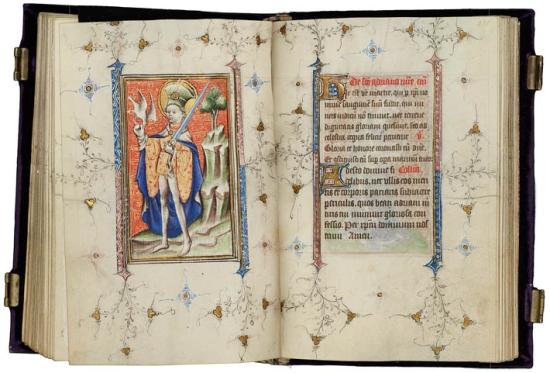
Book of Hours, in Latin
Illuminated by the Master of the Morgan Infancy Cycle
Purchased with the assistance of the Fellows, 1953
Adrian was a fourth-century pagan soldier before his conversion to Christianity, for which he was promptly martyred. Even by the standards of that era, his death was particularly brutal: his bones were crushed and his hands and head severed. In heaven his body — and his clothes — are resplendently restored. He wears a short embroidered pourpoint with luxurious poke sleeves. From his shoulders flows a long blue-lined cloak pinned at his throat with a gold morse. Chaussembles cover his lean legs and pointed feet, and he is crowned with a towering bonnet bedecked by a jeweled brooch with two feathers.
Luxury in a Time of Madness
In 1392 King Charles VI suffered the first of forty-four bouts of madness that would cripple his reign. During a lull in the Hundred Years' War, strife between France and Burgundy erupted into civil war. This domestic crisis was sparked by the 1407 assassination of Charles's brother by Duke John of Burgundy. In 1419 the duke, in turn, was murdered by supporters of the crown. During these tumultuous times, fashion reached unbelievable heights of luxury.
Men's and women's fashions were dominated by a new garment, the houpeland. Men's houpelands featured enormous sleeves and a skirt ranging from full length to crotch level. The pourpoint remained popular, albeit often finely embroidered and equipped with large sleeves. Accessories included fancy baldricks (sashes) and belts—both sometimes hung with bells. Tall bonnets or chaperons, often tied into imaginative shapes, completed the look.
Women's houpelands were always full length, with bombard or straight sleeves. The simpler cote hardy, with its voluminous skirt and tight upper body, continued to be worn. Women began to wear their hair in temples, a double-horned coif surmounted by veils or a tubular burlet.
